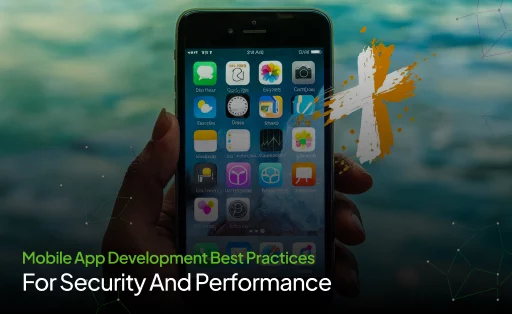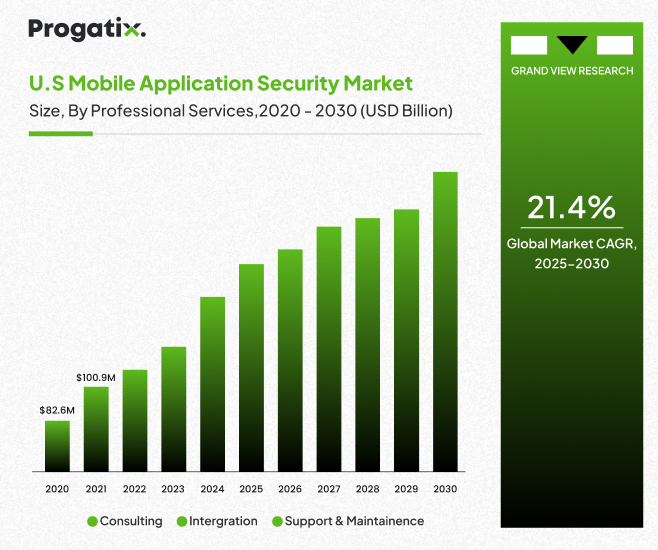Mobile App Development Best Practices For Security And Performance App Development

In today’s fast-driven digital world, mobile apps have become a crucial part of our daily lives, making security and performance more significant than ever. As mobile app usage endures to skyrocket, ensuring that your app is both safe and functions flawlessly is a top priority for developers and businesses similarly. Whether you’re working on healthcare, fintech, media, or any other sector, the challenge stays the same: building an app that secures user data while delivering a smooth experience.
This blog guide will address the best practices for building mobile apps focusing on improving efficiency and security. Read this blog to successfully build reliable, secure, and effective mobile applications that stand out in a crowded market, with practical insights on safe coding strategies to ensure smooth app functionality.
What Is Mobile App Security?
Security in the context of mobile applications denotes a set of guidelines, standards, and practices set to secure mobile apps from possible threats. Some of these practices are universal and relate to any type of application or device, while others are distinctly personalized for mobile devices, focusing on their unique features like cameras, sensors, and GPS. With the global mobile application security market reaching USD 2.00 billion in 2022 and anticipated to grow at a compound annual growth rate (CAGR) of 24.2% from 2023 to 2030, securing mobile apps has become more critical than ever, according to a report from GrandViewResearch.
As mobile applications remain to play a crucial role in daily business activities, mainly with the growth of remote work post-COVID-19 pandemic, ensuring the safety of these apps is dominant to secure against data theft, un-authorized access, and other risks. Mobile security features protect both software and hardware, ensuring that user data is kept safe in a progressively digital world.
Importance of Mobile App Security
Businesses throughout a variety of industries now depend heavily on mobile apps, especially for Android smartphones, which offer convenience, accessibility, and customized user experiences. The requirement for strong security measures is further highlighted by the increasing reliance on mobile apps. Mobile app security prevents data breaches while protecting private information, such as payment details and sensitive business data, as well as sensitive user and business data, because a single security breach could result in financial concerns, a decline in assurance, and even legal proceedings.
Reputation damage following such occurrences can be severe, as users expect their data to be safe, and recovering their trust is a difficult feat. Moreover, with regulations such as, GDPR and CCPA in place, businesses must ensure their apps meet safety and privacy standards or face hefty fines and damage to their reputation. Amongst the global fintech vendors and financial institutions, mobile app security is not just a technical issue, it’s a business imperative.
In the following sections, this blog will explore best practices for saving your mobile app and maintaining both data security and user trust.
Best Security for Mobile App Security
Mobile app security is a multi-faceted procedure that needs a proactive and detailed approach. Here are a few of the best practices that mobile application developers and businesses must consider:
-
Safe Coding Practices
Safe coding is the base of security for mobile applications, which includes writing code to lessen the introduction of security vulnerabilities. Few safe coding practices involve:
-
Avoid Hardcoding Sensitive Data
Hardcoding sensitive data such as API keys and passwords could expose your app to considerable risks. Instead, use safe processes such as environment variables or secure server-side controls.
-
Input Validation
Always validate user input to avoid attacks such as SQL injection and cross-site scripting. Input validation must be done both on the server side for security and on the client side for user experience.
-
Use Secure Communication Protocols
Use secure and encrypted communication protocols such as HTTPS and SSL/TLS to safeguard data in transit.
-
Regular Updates And Patches
Keeping your app updated is significant for security. Regular updates and patches fix known vulnerabilities and secure users from known threats. Updating your third-party app stores and third-party libraries is crucial, as outdated libraries could bring security risks.
-
Data Encryption
Data encryption is an important aspect of mobile app security, which includes changing data into a code to avoid unauthorized access. All crucial data that encrypt mobile communications at rest and in transit must be encrypted. This involves a user’s device data, business information, and any other sensitive details.
-
Additional Security Measures
Other than the above practices, numerous additional measures could improve mobile app store data security:
-
App Shielding Techniques
Techniques such as code obfuscation and encryption can secure your app from reverse engineering and altering.
-
Two-factor Authentication (2FA)
2FA incorporates an additional layer of safety by asking users to provide two forms of identification before accessing the app.
-
Security Threat Monitoring
Regularly monitor your app for security threats by penetrating tests, security audits, and automated security testing tools.
Remember, phone app security is a continuous process rather than a one-time task. It needs consistent monitoring, testing, and updating to stay ahead of upcoming threats.
Executing Security Best Practices
Executing mobile app security practices is a significant step in app development. It needs a strategic approach and a detailed understanding of potential app security evaluation of concerns and risks. Here are a few steps to guide you through this process:
Step 1: Comprehend Your App’s Architecture
Comprehending your app’s architecture is the first step when security best practices implementation is concerned. This includes knowing the data flow, identifying potential points of vulnerability, and understanding how different components of your app connect.
Step 2: Add Security from the Beginning
Security must be considered from the start of the app development process, not a reconsideration. This approach is usually known as “security by design”, ensuring that security measures are included in the app’s design and not just included later.
Step 3: Use Secure Coding Practices
As discussed earlier, safe coding practices build the base of mobile app security. This incorporates avoiding hardcoding crucial data into app code, executing input validation, and employing safe communication protocols.
Step 4: Regularly Update and Patch Your App
Keeping your app upgraded is important for security. Regular updates and patches fix known vulnerabilities and secure users from known risks. Keeping third-party libraries updated is crucial, as outdated libraries could introduce security risks.
Step 5: Encrypt Sensitive Data
All crucial data, both at rest and in transit, must be encrypted. This incorporates user data, business data, mobile communications, and any other data leaks or confidential details.
Step 6: Implement Extra Security Measures
Beyond the above practices, business apps must consider executing additional security measures such as two-factor authentication, app shielding techniques, and regular security threat monitoring.
Step 7: Test Your Security Measures
After the implementation of these security measures, it’s crucial to test them either through penetration tests, security audits, or automated security testing tools. Regular penetration testing also helps recognize potential vulnerabilities and ensures that your security measures work as planned.
Step 8: Keep Up With Evolving Threats
Mobile app security is a continuously developing field. New threats evolve regularly, and security best practices could change. Stay updated regarding the newest mobile security, trends and threats, and be ready to upgrade your mobile application security testing measures as required.
Remember, implementation of these best practices is not a one-time task but a continuous process which needs continuous monitoring, updating, and testing to stay ahead of future threats.
Enhance Speed And Security With Custom Apps!
Let's Connect
Challenges Faced in Mobile App Security
While implementing mobile app security best practices is important, it also comes with some challenges. Here are a few of the common obstacles developers and businesses come across and how to avoid them.
-
Keeping Up with Evolving Threats
The cybersecurity threat landscape is ever-changing, with new threats appearing on a regular basis. It can be difficult to stay ahead of these risks.
Solution:
- Regularly update your knowledge regarding the latest security trends and threats.
- Attend webinars, follow relevant blogs, and contribute to the forums.
- Consider using automated security testing tools that could help recognize new threats.
-
Balancing Security With Usability
For mobile apps, finding the ideal balance between security and usability is one of the greatest problems. Strong security measures must be put in place, but the user experience shouldn’t suffer as a result. Two-factor authentication, for example, can improve the security of your application but may also make it more challenging for people to use.
Solution:
Finding the balance is important. Ensure to conduct detailed usability testing along with implementing security measures. Gather user feedback and make required adjustments to ensure a smooth user experience.
-
Ongoing Monitoring And Evaluation
Mobile device and app security need continuous monitoring and evaluation, which could be resource-draining.
Solution:
Consider using automated security tools to monitor your app for safety threats and vulnerabilities. Additionally, build a culture of security within your team, where everyone comprehends the significance of security and is dedicated to keeping it.
-
Ensuring Compliance With Regulatory Standards
Ensuring compliance can be tough with the growth of regulatory standards such as CCPA and GDPR. Non-compliance could lead to hefty fines and damage to a company’s reputation.
Solution:
Stay updated regarding the latest regulatory standards and ensure your app complies. This could include conducting regular audits and seeking legal advice.
-
Managing Third-Party Libraries
Numerous apps use third-party libraries, which could introduce other security concerns and risks if they need to be regularly upgraded or contain susceptibilities.
Solution:
Update all third-party libraries regularly, alongside monitoring them for vulnerabilities. Consider using tools that could automatically check for vulnerabilities in these libraries.
Final Words
In conclusion, mobile app security should be taken into account throughout every step of the app development process. It’s not only about safeguarding the application, but mainly it’s about protecting the confidential and sensitive data that these apps manage. A single security breach might have negative effects, including lower trust, financial challenges and legal problems.
Secure code, frequent updates and patches, data encryption, and extra security measures such as, two-factor authentication and app shielding techniques are all required to apply these security best practices, as we’ve covered in our discussion on mobile security tips. But it’s also essential to realize that these procedures are a continuous process that calls for constant testing, updating, and monitoring.
Mobile app security poses some obstacles, but these may be addressed with the right approach, tools, and dedication to security. Remember that safe mobile applications need to combine security and usability, and stay up to date with the most recent security updates and mobile malware threats.
How Progatix Can Help?
Progatix, a leading custom software and mobile app development company, is skilled in delivering next-gen custom software solutions that drive business growth and innovation. By implementing strong security measures, complying with the industry’s best practices, and continuously improving performance, we ensure that your software exceeds the highest requirements for both security and user experience. With Progatix, get creative, scalable solutions that speed up the expansion of your business, whether you’re developing a new app or releasing an update.
Your App, Secured And Optimized By Our Professionals!
Let's Connect



 Let's Discuss Your Tech Solutions
Let's Discuss Your Tech Solutions 





